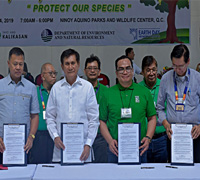Paggamit ng mercury tatanggalin sa small-scale mining
Pumasok ang Pilipinas sa five-year project na layuning maiwasan ang paggamit ng highly toxic mercury sa artisanal and small-scale gold mining (ASGM).
Ang proyektong ito ay pinondohan ng Global Environment Facility (GEF) kung saan ay magsisilbing implementing agency ang Department of Environment and Natural
Resources (DENR), pakay nito na maging ligal ang pagsuporta sa ASGM at hinihikayat din ang mga minero na gumamit ng mga alternatibong pamalit sa mercury.
Ayon kay DENR Undersecretary Analiza Rebuelta Teh, ang GEF-Global Opportunities for Long-Term Development (GEF-GOLD) project ay isang paraan upang
matulungan ang mga small-scale miners na handang sumunod sa polisiya ng gobyerno at maging responsable sa pagmimina.
Aniya, layon din ng proyektong ito na matulungan ang Pilipinas upang makibahagi sa eliminasyon ng paggamit ng mercury sa ASGM sa pamamagitan ng “chain approach” na
“miners to refiners.”
“We hope that small-scale miners will see mercury-free gold mining as viable,” sabi pa ni Teh na nagsilbi ring focal point person ng GEF-Philippines.
Ang mercury na kilala rin sa tawag na “quicksilver” ay kadalasang ginagamit sa ASGM bilang “magnet” upang makuha ang ginto na nakahalo sa lupa at iba pang bagay.
Maaari itong makaapekto sa mga minero na “expose” sa metal dahil makaaapekto ito sa nervous, immune at digestive systems ng tao.
Bukod sa Pilipinas, ang GEF-GOLD project na may alokasyon na aabot sa halagang US$45 million ay iniimplementa rin sa Peru, Columbia, Guyana, Indonesia, Kenya, Burkina,
Faso at Mongolia.
Ang mga project sites sa Pilipinas ay matatagpuan sa Maco sa Compostela Valley, T’boli sa South Cotabato at Rosario sa Agusan del Sur.
Kabilang sa mga bahagi ng proyekto ay ang mga sumusunod: review of policies and legal frameworks supporting the ASGM sector; introduction of financing schemes allowing
miners to invest in sustainable mercury-free technologies; upscaling of these technologies; dissemination of information to ensure replication; and monitoring and evaluation.
Ayon sa Mines and Geosciences Bureau (MGB) ng DENR, umaabot sa 38 ang small-scale mining sites sa Caraga region habang 78 naman ang nasa Cordillera Administrative
Region.
Ang small-scale mining ay protektado ng Republic Act 7076 o ang People’s Small-Scale Mining Act bukod pa dito ang Executive Order 79 na nag-aatas sa pagkakaroon ng
“minahang bayan”.
Sa kasalukuyan, umaabot sa 26 ang idineklarang minahang bayan sites. Bukod sa pag-promote ng mercury-free gold mining, isinusulong din ng GEF-GOLD
project na matutukan ang isyu sa ASGM kabilang na dito ang working conditions, child labor at gender gap.
Ang naturang proyekto ay isa ring istratehiya upang mapabilis ang pagratipika ng senado sa Minamata Convention on Mercury.
Hindi lamang sa ASGM makikita ang mercury dahil may presensiya din ito sa fuels, recycled metals, whitening cosmetics, batteries at dental fillers.
Kamakailan lamang nitong taon nang magsagawa ng assessment sa epekto ng mercury sa ating kapaligiran at labing-isang lugar ang lumalabas na kontaminado ng naturang
metal kabilang na dito ang Manila Bay. ###
- Details
- Parent Category: News & Events
- Category: Press Releases




